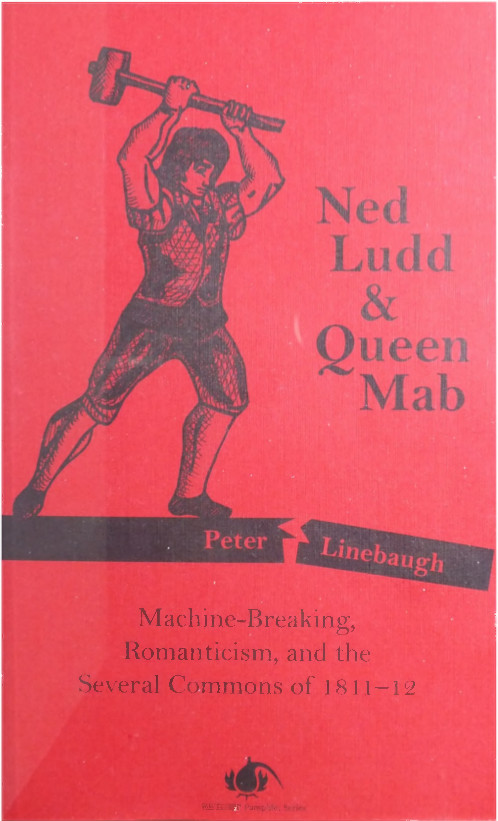Peter Linebaugh: Ned Ludd and Queen Mab: Machine-Breaking, Romanticism, and the Several Commons Of 1811-12 (2012)
Filed under pamphlet | Tags: · 1800s, luddism, machine, romanticism

“Peter Linebaugh, in an extraordinary historical and literary tour de force, enlists the anonymous and scorned 19th century loom-breakers of the English midlands into the front ranks of an international, polyglot, many-colored crew of commoners resisting dispossession in the dawn of capitalist modernity.”
Publisher PM Press, Oakland, CA, 2012
Report Pamphlet Series, No. 001
ISBN 9781604867046
48 pages
review (Alan Brooke)
author’s lecture on luddism (audio)
Andrew Piper: Dreaming in Books: The Making of the Bibliographic Imagination in the Romantic Age (2009)
Filed under book | Tags: · book, literature, publishing, romanticism, translation

At the turn of the nineteenth century, publishing houses in London, New York, Paris, Stuttgart, and Berlin produced books in ever greater numbers. But it was not just the advent of mass printing that created the era’s “bookish” culture. According to Andrew Piper, romantic writing and romantic writers played a crucial role in adjusting readers to this increasingly international and overflowing literary environment. Learning how to use and to want books occurred through more than the technological, commercial, or legal conditions that made the growing proliferation of books possible; the making of such bibliographic fantasies was importantly a product of the symbolic operations contained within books as well.
Examining novels, critical editions, gift books, translations, and illustrated books, as well as the communities who made them, Dreaming in Books tells a wide-ranging story of the book’s identity at the turn of the nineteenth century. In so doing, it shows how many of the most pressing modern communicative concerns are not unique to the digital age but emerged with a particular sense of urgency during the bookish upheavals of the romantic era. In revisiting the book’s rise through the prism of romantic literature, Piper aims to revise our assumptions about romanticism, the medium of the printed book, and, ultimately, the future of the book in our so-called digital age.
Publisher University of Chicago Press, 2009
ISBN 0226669726, 9780226669724
319 pages
Niklas Luhmann: Art as a Social System (1995/2000)
Filed under book | Tags: · aesthetics, art, art system, autopoiesis, communication, cybernetics, perception, romanticism, social theory, systems theory

This is the definitive analysis of art as a social and perceptual system by Germany’s leading social theorist of the late twentieth century. It not only represents an important intellectual step in discussions of art—in its rigor and in its having refreshingly set itself the task of creating a set of distinctions for determining what counts as art that could be valid for those creating as well as those receiving art works—but it also represents an important advance in systems theory.
Returning to the eighteenth-century notion of aesthetics as pertaining to the “knowledge of the senses,” Luhmann begins with the idea that all art, including literature, is rooted in perception. He insists on the radical incommensurability between psychic systems (perception) and social systems (communication). Art is a special kind of communication that uses perceptions instead of language. It operates at the boundary between the social system and consciousness in ways that profoundly irritate communication while remaining strictly internal to the social.
In seven densely argued chapters, Luhmann develops this basic premise in great historical and empirical detail. Framed by the general problem of art’s status as a social system, each chapter elaborates, in both its synchronic and diachronic dimensions, a particular aspect of this problem. The consideration of art within the context of a theory of second-order observation leads to a reconceptualization of aesthetic form. The remaining chapters explore the question of the system’s code, its function, and its evolution, concluding with an analysis of “self-description.”
Art as a Social System draws on a vast body of scholarship, combining the results of three decades of research in the social sciences, phenomenology, evolutionary biology, cybernetics, and information theory with an intimate knowledge of art history, literature, aesthetics, and contemporary literary theory. The book also engages virtually every major theorist of art and aesthetics from Baumgarten to Derrida.
Originally published in German in 1995 under the title Die Kunst der Gesellschaft, Suhrkamp, Frankfurt am Main
Translated by Eva M Knodt
Publisher Stanford University Press, 2000
Meridian: Crossing Aesthetics series
ISBN 0804739072, 9780804739078
422 pages
PDF (updated on 2012-7-17)
Comment (0)
